Ghost wants to be the next big thing in blogging. Like any good WordPresser, I wanted to get my grubby little mitts all over it and see what all the fuss is about.
Originally funded for development via Kickstarter, Ghost is a blogging platform that very recently pushed into its primetime 1.0 release. That’s big news for folks like us, those who want to stay on the cutting edge of web development and publishing.
So the release of Ghost 1.0 was a good spot to dig in and check out how things have progressed since the Kickstarter.
Just What is Ghost?
First off, Ghost is open-source. For WordPress folks like us, that’s great news. But we have to remember that not all open-source is created equal. Multiple licenses exist for distribution, and Ghost is put out under the MIT license, whereas WordPress is maintained as GPL.
You can read about the differences in a couple of places. Unless you’re a developer or themester, the MIT vs GPL side of things may not affect you much.
Other than that, it’s a pretty straightforward publishing platform with a theme marketplace, local development tools, and a slickity-smooth interface that honestly puts the WordPress admin panel to shame in terms of design.
Getting Started With Ghost 1.0
You have two options when starting with Ghost: you can purchase hosting from the parent company through their Ghost(Pro) program (think about it like managed WP hosting), or you can install it on your own host (pretty simple, so far, right?)
Here’s the catch: you get a choice of only six hosts that support Ghost.
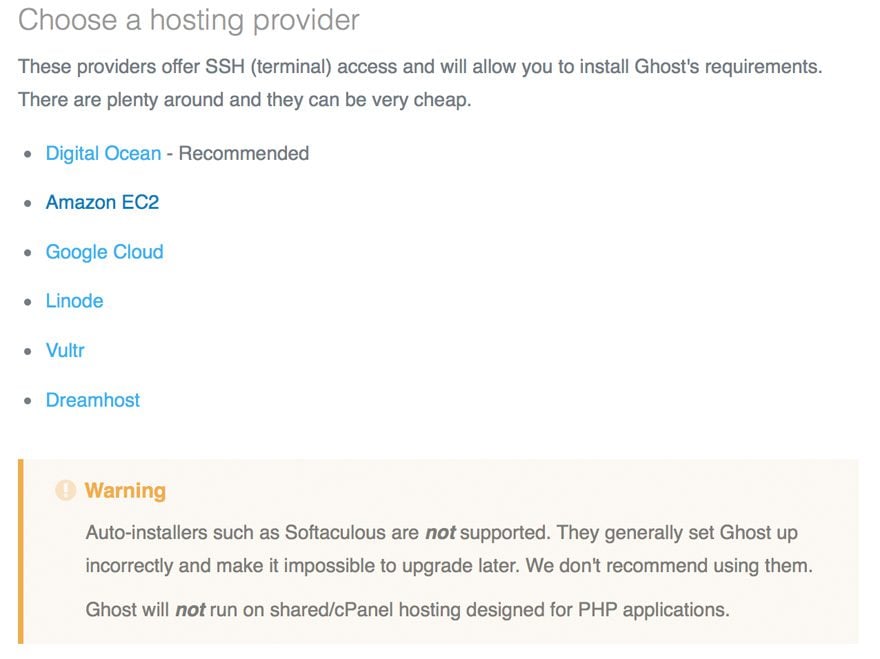
If you’re used to the ubiquity of WordPress, that feels almost claustrophobic.
For my purposes, I signed up for a 14-day trial of Ghost(Pro) to play with the web interface, and I did the local installation, where I could do pretty much whatever I wanted in my own little sandbox with the desktop client.
Installing Ghost 1.0 Locally Stinks
Famous 5-Minute Install, this is not.
I’m a techie kind of guy. I am comfortable with a command line. So when I saw that Ghost’s recommended system was Ubuntu 16.04, my eyes lit up. “That’s what I use!” my mind screamed in excitement. So I promptly followed their instructions, and…
Error. After error. After error.
First off, my version of Node was wrong. Ghost only supports Node versions 4 to 6.5. I was running 8.x. No worries. Install Node Version Manager (nvm), swap to 6.5, easy peasy.
Nope. Now there’s an issue with the SQLite3 installation. The Ghost CLI didn’t install it right (despite it already being installed and updated on my system). Uninstall, reinstall. Same thing.
They said to swap to MySQL then. Okee dokey. Nope, still not going to run. And…somehow in this mess, Ubuntu decided that I didn’t have nvm installed anymore. Ugh.
None of this was hard, mind you–just frustrating.
I take a break, make a sandwich, and swap to my Macbook (running MacOS Sierra and fully updated). I mean, it’s Unix, so it can’t be that different to install.
And it wasn’t. Exactly the same errors happened. In exactly the same order. Node versions. Problems with SQLite3 installation. Problems with MySQL. Forgetting nvm is there.
Ugh.
Eventually, I poke and prod and update and uninstall and reinstall, and things work. Like I said, I’m comfortable in the command line, but I can’t tell you what made it eventually work because I tried so many things.
In the end, it took over a dozen attempts to get Ghost installed and working on a computer. (I didn’t try Windows 10, though, so it may be a better experience there. Let me know!)
Using Ghost
I load things up, hit the localhost URL in my browser, and there’s no admin panel. No way to edit posts. Nothing. I am simply a user. I have a clean website, full of tutorials and pre-filled content, and no way to add my own.
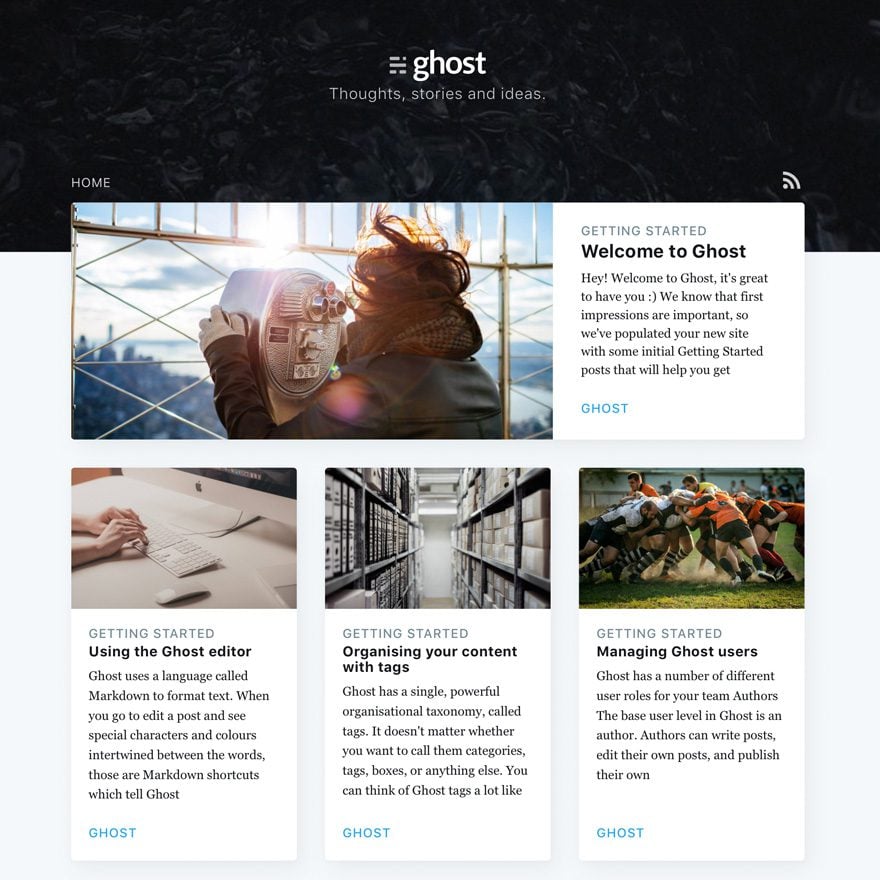
After looking around a bit, I find out there’s a desktop client. It installs easily (yay!), and it asks for my URL (the localhost one) and a username. I have no idea, so I just type one in, and it creates my blog user automatically.
Weirdly enough, the desktop client isn’t an installer as well. Hopefully in future releases that happens because I cannot see most people going to the trouble I did.
Additionally, the desktop client is the only way to edit and publish. There is no web interface (that I can find) unless you are using the Ghost(Pro) service for hosting. If you go with one of the other hosts, you’ll be using the command line and desktop app.
There’s no mobile app yet, either. So keep that in mind.
After using both interfaces for a while, I am pretty sure they’re exactly the same. I like that a lot. Unified design means a lot to me (and to the Ghost folks, too).
The Editor Itself
In the spirit of really giving Ghost 1.0 a shot, I have written this post entirely in the Ghost editor. From note taking and experimenting, to editing, I bounced between the desktop and web client until finalizing the post in WordPress.
I gotta say, I like it.
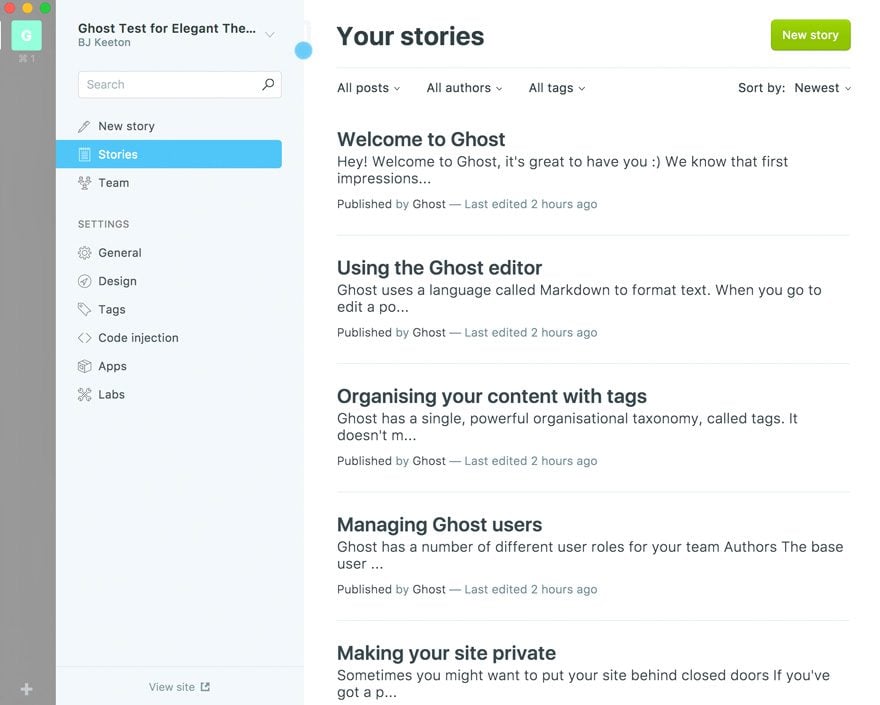
But for folks used to WordPress, it may take some getting used to. You see, it’s a markdown editor, not a WYSIWYG/plain-text editor like we’re used to. You can still use HTML, though, if you’re not familiar with markdown syntax. If you’ve ever left Reddit comments or contributed to Github, you’ve probably seen or used markdown.
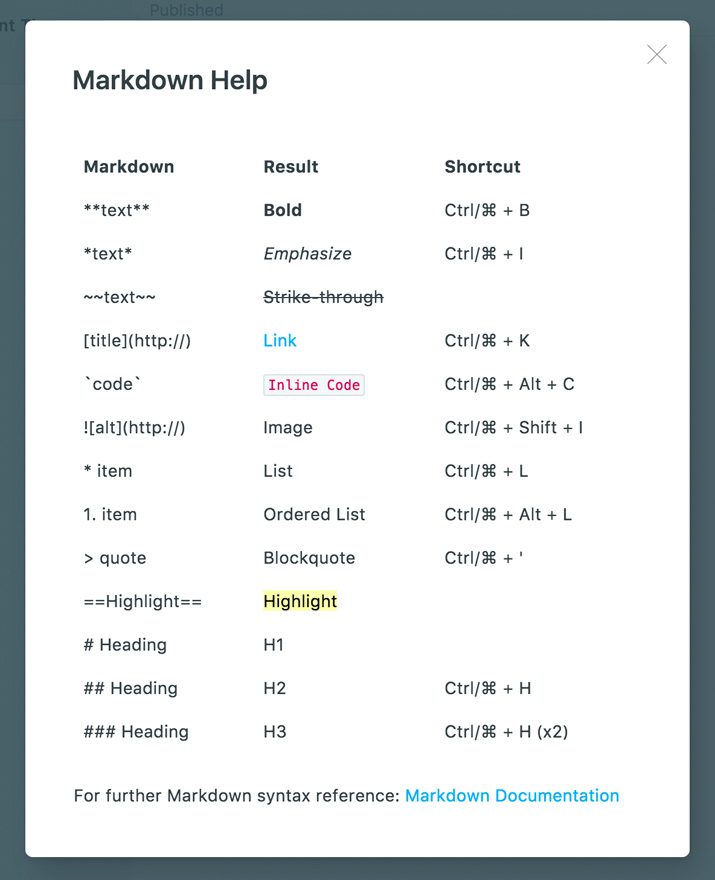
There are two editing modes: single pane (just the markdown or HTML), and double-paned, side-by-side editor. The double panes are very, very nice, especially if you’re new to markdown–you can see exactly what the symbols do in real time and check your formatting as you go–helps with typos and missing tags and such.

But–and there’s always a but, isn’t there?–because it’s two-columned, even on the fully-scaled MacBook Pro Retina display that I am using, it felt kind of awkward to write in. But then again, I don’t like the WordPress distraction-free mode, either. So there’s that.
Posting and Ghosting
Posting is super easy, and every option you need is a single click away. Open up the post settings, and you get access to the post image, meta data, Twitter cards, Facebook cards, and even header/footer scripts.
Every bit of it is easily edible and understandable.
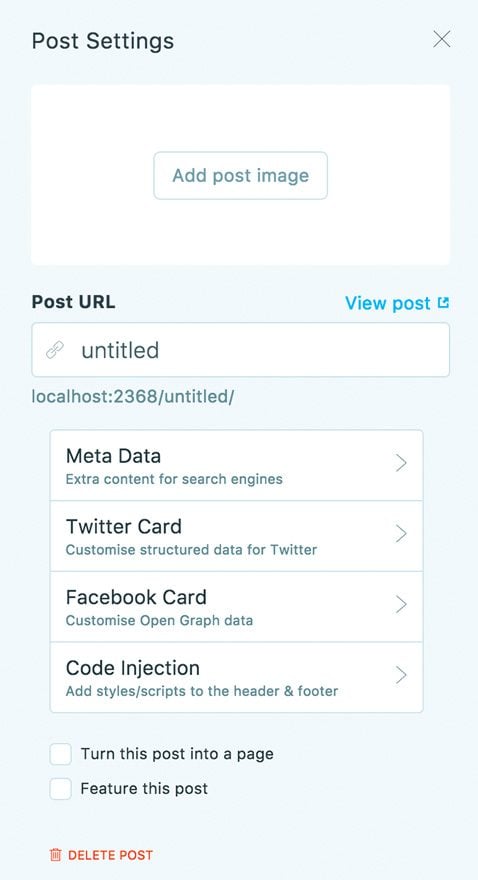
I have had some issues with URL slugs not working quite right. It will add “-post” to the end of my slugs occasionally, or if I click away from the title field when it’s blank, the slug is forever set to “untitled.” It’s a small bug that will be ironed out in future releases, I’m sure.
Those kinds of bugs are minor annoyances for a hobbyist, but major issues for a large company (which is a major target of the Ghost software) because writers and editors can easily miss that kind of error.
Deleting a post, however, is not so intuitive. There is a single place to delete a post, and it’s at the bottom of those individual post settings. You can’t do it from the post list at all, which needs to be addressed.
I also could not find a way to sort my draft posts separately, just tagged with a red draft icon in the main list of posts. Which again, I am sure will be fixed in the future.
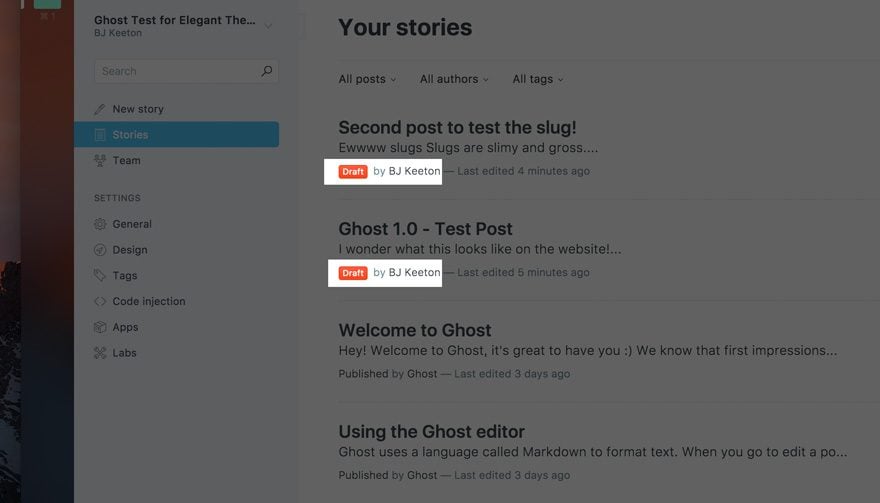
Ghost 1.0 Feels Comfortable and Clean
Design and the user experience matters to the Ghost Foundation. Using Ghost 1.0 is pleasant, and I feel right at home from the moment I load it up.
The software, both on the front-end and the administrative side feels similar to Squarespace and Medium. If you’ve ever used either of those, Ghost will take you very little getting used to.
The speed is great, there is no lag whatsoever in the editor or display. Even if you go with the default theme (which is all I toyed with), it’s polished and clean enough to use, even if it is pretty cookie cutter.
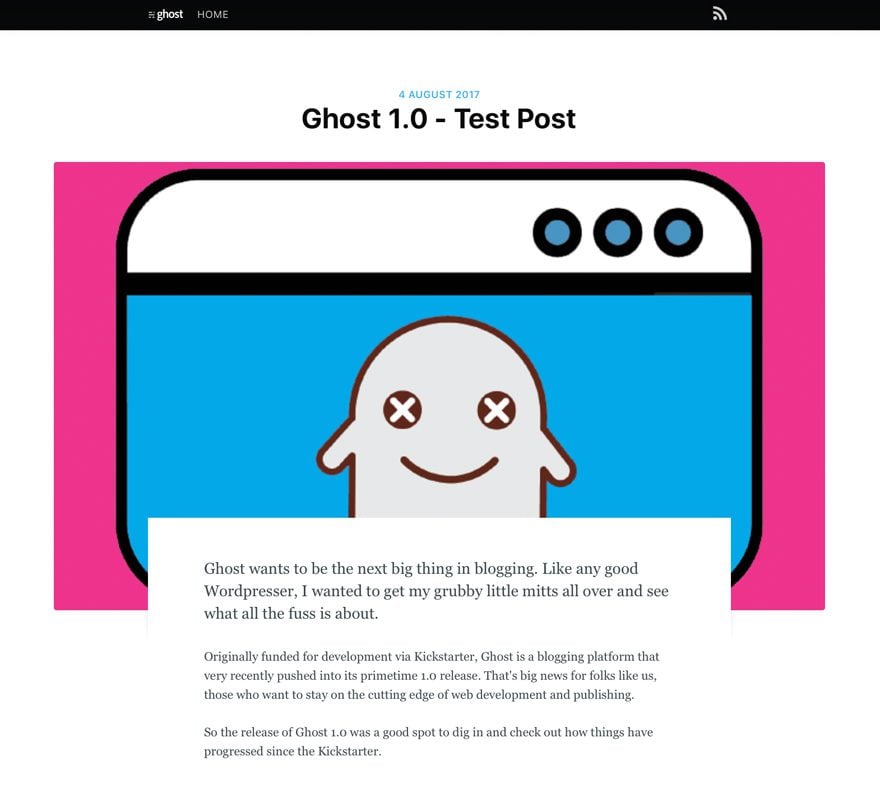
The Ghost 1.0 release feels like what Squarespace would be if you took the training wheels off, or maybe like Medium if you had full control of the publishing platform.
Ghost may also be what Gutenberg aspires to be in the long-term. And that’s not necessarily a bad thing for the publishing side of WordPress.
Conclusion? To Be Continued…
I really don’t think it’s possible to draw a firm conclusion about Ghost 1.0. It’s a bit early in its life to pass judgment. So I am going to just leave it as a to be continued.
The software itself is awesome, but it’s new. When it was first announced, I saw tons of articles about how it was a WordPress killer. That’s just plain silly.
First of all, WordPress has 13 years of a head start and over a quarter of the internet runs on it. It’s going nowhere.
WordPress is also a content management system. It isn’t used solely for blogging and publishing.
Ghost is.
Ghost is a publishing platform, first and foremost. On the website, the header says it as clear as day.
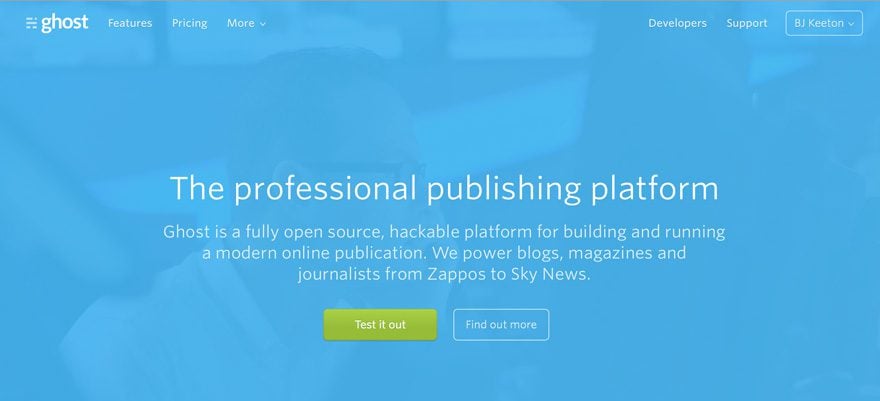
They tout themselves as a professional publishing platform, which is an inherently different audience than WordPress targets.
Sure, in a broad sense, WordPress and Ghost are competitors. They’re competitors in the way that Windows and Linux are competitors: they kind of do the same thing, but they aren’t really even in the same market.
You can’t run an e-commerce store from Ghost or use the software as a server endpoint for an iOS app. You can do that with WordPress.
Ghost is not on track for that. That’s okay. That’s not what their niche is. They want to do publishing exceptionally well, and they are on track for that.
So What’s Next for Ghost 1.0?
“Ghost 1.1?” you say. Well, to get it there, the Ghost Foundation will depend on you, actually. Since this is open source software, Ghost wants you to get involved in the development. They actively want you to contribute to the software.
Their team is everywhere, and the support is awesome. So no matter if you prefer Github, Twitter, Slack, whatever–someone will talk to you about Ghost, your experience with it, and how you/they can improve it.
My Final Take
Ghost does so much well. It’s fun to write in, and once it’s installed, it works incredibly well. But that installation…boy, oh boy, was that awful.
If the team behind Ghost really wants to bring this to WordPress-level ubiquity, they need to tone down the “for coders” mentality of it a bit.
WordPress attracts a lot of people because of its ease of use. You can do a lot with just a knowledge of HTML and CSS.
By contrast, Ghost uses Handlebars as the templating language and works primarily in JavaScript via Ember and Node. There’s a good chance that stack could potentially alienate some users.
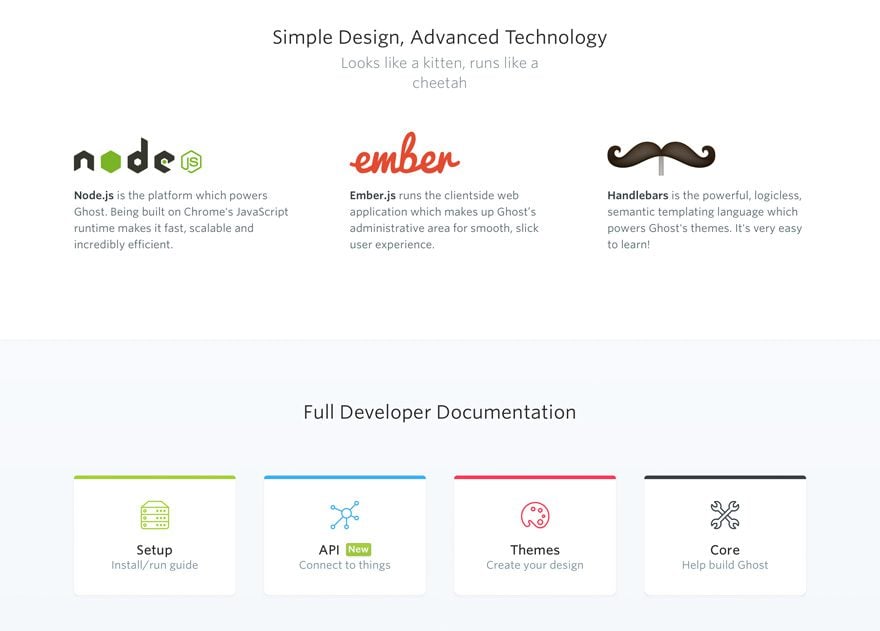
That said, they’re not necessarily targeting small businesses and hobbyists like WordPress does. So having an entirely JS based stack, from development to the end-user could draw a lot of business attention (and future-proof their product, given the explosion of JavaScript growth in recent years).
Outside of picking that nit, installation for self-hosting really, really, really, really needs to be simplified. It may never get to WordPress-level simplicity, but it shouldn’t take someone who understands bash and the command line to take a dozen stabs at it over two different operating systems (and still end up failing entirely on one OS).
Who You Gonna Call?
Not Ghostbusters, that’s for sure. Not this time. This is one ghost, I’ll happily let haunt me for a while.
I really, really like Ghost 1.0. Or maybe Ghost’s potential. At this stage in the game, that’s pretty much the same thing.
What we have in this release is a fantastic product that, by the time it hits release 2.0 or 3.0, could be a real contender in the publishing arena.
Article thumbnail image by gst / shutterstock.com
The post Ghost 1.0 – The Spirit of Blogging Future? appeared first on Elegant Themes Blog.
